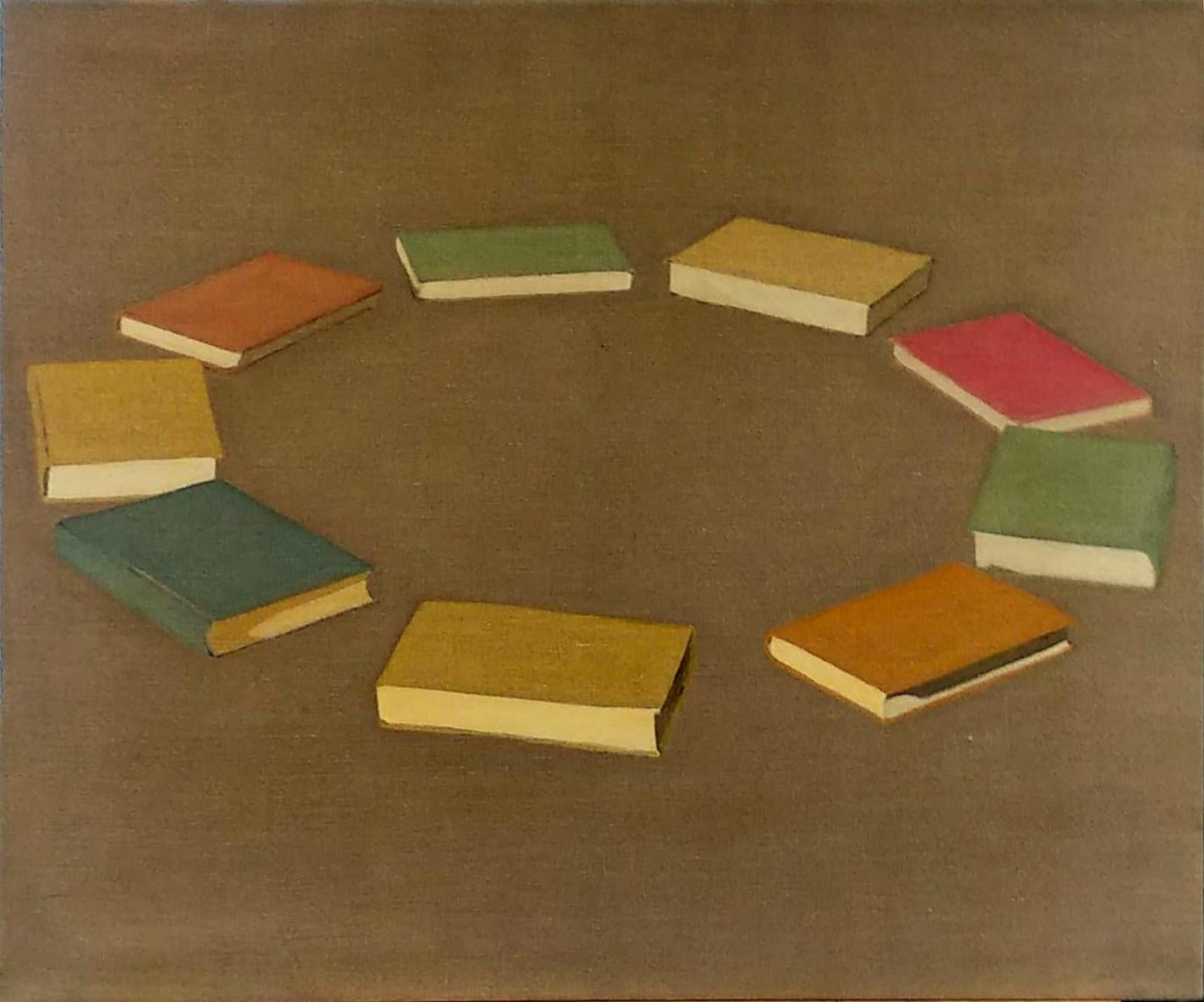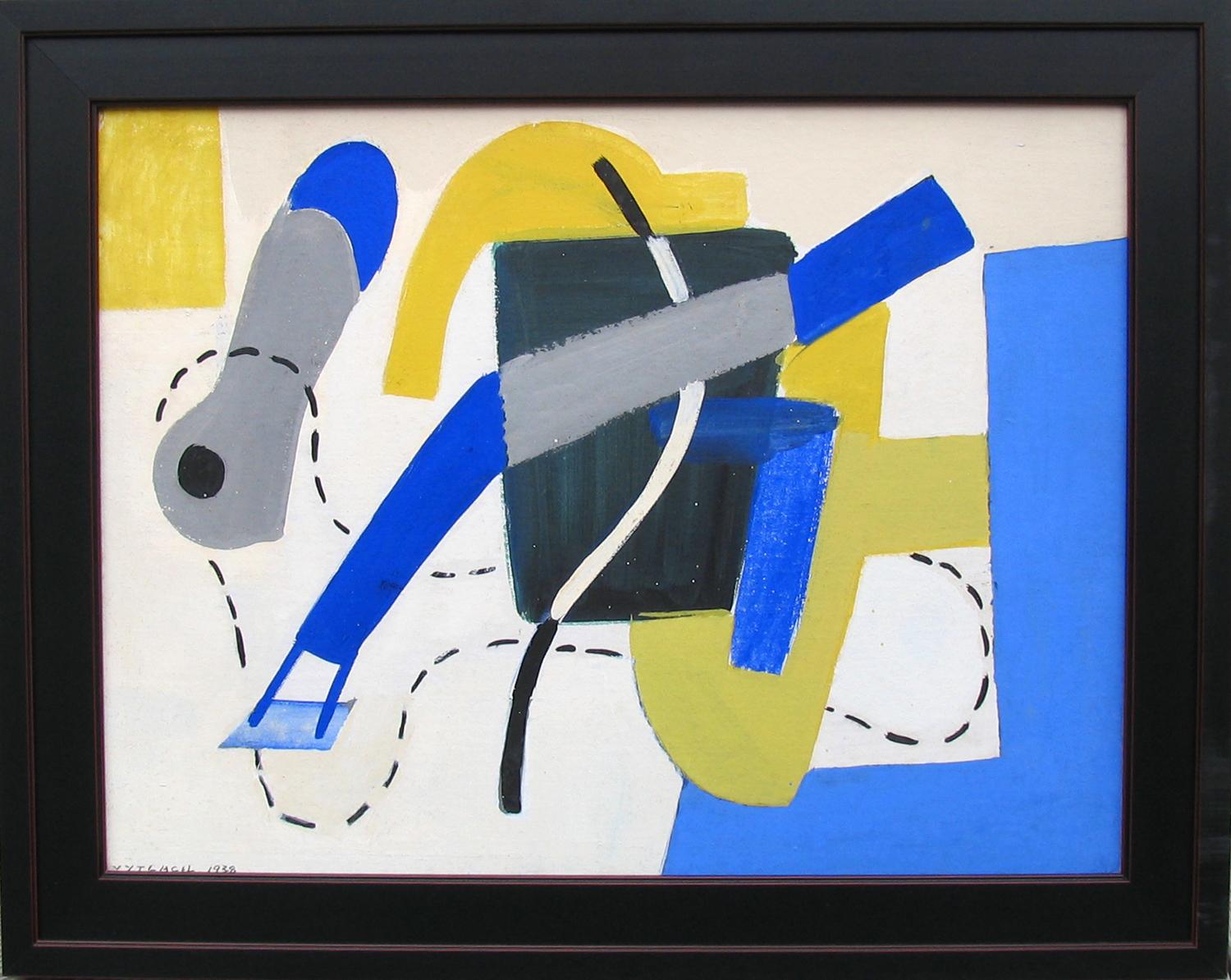Items Similar to Composition - American painting, Post War Art
Want more images or videos?
Request additional images or videos from the seller
1 of 5
Mark TobeyComposition - American painting, Post War Art1968
1968
About the Item
MARK TOBEY 1890-1976
Centerville 1890 - 1976 Basel (American)
Title: Composition, 1968
Technique: Original Tempera Painting on Paper
Paper size: 15.5 x 11.5 cm. / 6.1 x 4.5 in.
Additional information:
The work is hand signed and dated in blue ink by the artist “Tobey 68” [1968} at the lower right corner.
This work is a tempera painting.
Artist’s One-man Shows:
Whitney Museum of American Art, New York, 1951
Musée des Arts Décoratifs, Paris, 1961
Museum of Modern Art, New York, 1962
Stedelijk Museum, Amsterdam, 1966
Dallas Museum of Fine Arts, Dallas, 1968
National Collection of Fine Arts, Smithsonian, Washington, 1974
Museo Nacional Centro de Arte Reina Sofía, Madrid, 1999
Condition: Excellent condition.
- Creator:Mark Tobey (1890-1976, American)
- Creation Year:1968
- Dimensions:Height: 6.11 in (15.5 cm)Width: 4.53 in (11.5 cm)
- Medium:
- Period:
- Condition:
- Gallery Location:London, GB
- Reference Number:1stDibs: LU1804737731
About the Seller
4.7
Gold Seller
These expertly vetted sellers are highly rated and consistently exceed customer expectations.
Established in 1981
1stDibs seller since 2013
159 sales on 1stDibs
Typical response time: 10 hours
- ShippingRetrieving quote...Ships From: London, United Kingdom
- Return PolicyA return for this item may be initiated within 3 days of delivery.
More From This SellerView All
- Forms Sound Forme rumore, Futurism, Abstract ArtBy Giacomo BallaLocated in London, GBGIACOMO BALLA 1871-1958 Torino 1871 - 1958 Rome (Italian) Title: Forms Sound Forme rumore, 1925/30 Technique: Signed Tempera on Card Size: 19 x 22.7 cm. / 7.5 x 8.9 in. Addition...Category
1920s Abstract Paintings
MaterialsTempera
- Composition with Yellow CircleBy Edik Edward Arcadievich SteinbergLocated in London, GBEDIK EDWARD ARCADIEVICH STEINBERG b. 1937 born in Moscow 1937 (Russian) Title: Composition with Yellow Circle, 1989 Technique: Original Hand Signed and Dated Gouache Painting on cardboard size: 54 x 60 cm cm / 21.3 x 23.6 in Additional information: This original painting is hand signed and dated by the artist. It was painted in 1989. Provenance: Acquired directly from the artist by the previous owner. Exhibited: Paris & Tel Aviv, Galerie Le Minotaure...Category
1980s Contemporary Abstract Paintings
MaterialsGouache
- Brown Abstraction - The WallsBy Lili OrszagLocated in London, GBLILI ORSZAG 1926 - 1978 (Hungarian) Title: Brown Abstraction - The Walls Technique: Original Oil on paper Size: 28 x 16 cm. / 11 x 6.2 in. Additional Information: This original...Category
1950s Abstract Abstract Paintings
MaterialsOil
- Figures / AlakokBy Antal BiroLocated in London, GBANTAL BIRO 1907-1990 Pozsony 1907-1990 Székesfehérvár (Hungarian) Title: Figures / Alakok, 1950-1952 Technique: Original Signed and Oil Painting on Board size: 21 x 31 cm / 8.3 x...Category
1950s Abstract Abstract Paintings
MaterialsOil
- Abstract Composition - Signed Painting Hungarian CubismBy Alfred RethLocated in London, GBALFRED RETH 1884-1966 Budapest 1884-1966 Paris (Hungarian/French) Title: Abstract Composition, 1939 Technique: Original Signed and Dated Oil and Mixed Technique painting on Board ...Category
1930s Cubist Abstract Paintings
MaterialsOil
- Composition on Violet BackgroundBy Etienne BeothyLocated in London, GBETIENNE BEOTHY 1897-1961 Heves, Hungary 1897 - 1961 Paris (Hungarian/French) Title: Composition on Violet Background, 1927 Technique: Original Hand Signed and Dated Gouache Paintin...Category
1920s Abstract Abstract Paintings
MaterialsGouache
You May Also Like
- Hanan Shlonsky, Circle of Literature, 2007 tempera on linen, 82x100 cmLocated in Jerusalem, ILHanan Shlonsky Circle of Literature, 2007 tempera on linen 82x100 cm Exhibited: Comparative Literature, 2009 Artists' House Tel-Aviv , paintings on l...Category
2010s Minimalist Figurative Paintings
MaterialsTempera, Linen
- "We Recognize the Impermanence of Life Yet we feel the Attachments..." paintingLocated in Phoenix, AZCarrie Marill "We Recognize the Impermanence of Life... Yet we feel the Attachments... This is what gives our Lives those Special Textures...", 2017-2021 egg tempera and acrylic on l...Category
2010s Contemporary Abstract Paintings
MaterialsLinen, Acrylic, Egg Tempera
- Ceremonial Dancers oil and tempera painting by Julio De DiegoBy Julio de DiegoLocated in Hudson, NYArtwork measures 48" x 30" and framed 56 ¼" x 38 ¼" x 3" Provenance: John Heller Gallery, NYC, circa 1975 (label verso) The artist's daughter Corbino Galleries, Sarasota, FL (1990)...Category
1940s Modern Abstract Paintings
MaterialsMasonite, Oil, Tempera
- The Magician oil and tempera painting by Julio de DiegoBy Julio de DiegoLocated in Hudson, NYJulio De Diego’s Atomic Series paintings made an extraordinary statement regarding the shock and fear that accompanied the dawn of the nuclear age. In the artist’s own words, “Scientists were working secretly to develop formidable powers taken from the mysterious depths of the earth - with the power to make the earth useless! Then, the EXPLOSION! . . . we entered the Atomic Age, and from there the neo-Atomic war begins. Explosions fell everywhere and man kept on fighting, discovering he could fight without flesh.” To execute these works, De Diego developed a technique of using tempera underpainting before applying layer upon layer of pigmented oil glazes. The result is paintings with surfaces which were described as “bonelike” in quality. The forms seem to float freely, creating a three-dimensional visual effect. In the 1954 book The Modern Renaissance in American Art, author Ralph Pearson summarizes the series as “a fantastic interpretation of a weighty theme. Perhaps it is well to let fantasy and irony appear to lighten the devastating impact. By inverse action, they may in fact increase its weight.” Exhibited 1964 Marion Koogler McNay Art Institute, San Antonio, Texas This work retains its original frame which measures 54" x 42" x 2" About this artist: Julio De Diego crafted a formidable persona within the artistic developments and political struggles of his time. The artist characterized his own work as “lyrical,” explaining, “through the years, the surrealists, the social-conscious painters and the others tried to adopt me, but I went my own way, good, bad or indifferent.” [1] His independence manifested early in life when de Diego left his parent’s home in Madrid, Spain, in adolescence following his father’s attempts to curtail his artistic aspirations. At the age of fifteen he held his first exhibition, set up within a gambling casino. He managed to acquire an apprenticeship in a studio producing scenery for Madrid’s operas, but moved from behind the curtains to the stage, trying his hand at acting and performing as an extra in the Ballet Russes’ Petrouchka with Nijinsky. He spent several years in the Spanish army, including a six-month stretch in the Rif War of 1920 in Northern Africa. His artistic career pushed ahead as he set off for Paris and became familiar with modernism’s forays into abstraction, surrealism, and cubism. The artist arrived in the U.S. in 1924 and settled in Chicago two years later. He established himself with a commission for the decoration of two chapels in St. Gregory’s Church. He also worked in fashion illustration, designed magazine covers and developed a popular laundry bag for the Hotel Sherman. De Diego began exhibiting through the Art Institute of Chicago in 1929, and participated in the annual Chicago Artists Exhibitions, Annual American Exhibitions, and International Water Color Exhibitions. He held a solo exhibition at the Art Institute of Chicago in the summer of 1935. Though the artist’s career was advancing, his family life had deteriorated. In 1932 his first marriage dissolved, and the couple’s young daughter Kiriki was sent to live with friend Paul Hoffman. De Diego continued to develop his artistic vocabulary with a growing interest in Mexican art. He traveled throughout the country acquainting himself with the works of muralists such as Carlos Merida, and also began a collection of small native artifacts...Category
1940s American Modern Abstract Paintings
MaterialsMasonite, Oil, Tempera
- Untitled Abstraction casein tempera on board by Vaclav VytlacilBy Vaclav VytlacilLocated in Hudson, NYSigned and dated "Vytlacil 38" lower left, and signed and dated verso. Provenance: Estate of the artist #1602; Martin Diamond Fine Art About this artist: Born in 1892 to Czechoslov...Category
1930s Abstract Expressionist Abstract Paintings
MaterialsTempera, Casein, Board
- St. Atomic oil and tempera painting by Julio de DiegoBy Julio de DiegoLocated in Hudson, NYJulio De Diego’s Atomic Series paintings made an extraordinary statement regarding the shock and fear that accompanied the dawn of the nuclear age. In the artist’s own words, “Scientists were working secretly to develop formidable powers taken from the mysterious depths of the earth - with the power to make the earth useless! Then, the EXPLOSION! . . . we entered the Atomic Age, and from there the neo-Atomic war begins. Explosions fell everywhere and man kept on fighting, discovering he could fight without flesh.” To execute these works, De Diego developed a technique of using tempera underpainting before applying layer upon layer of pigmented oil glazes. The result is paintings with surfaces which were described as “bonelike” in quality. The forms seem to float freely, creating a three-dimensional visual effect. In the 1954 book The Modern Renaissance in American Art, author Ralph Pearson summarizes the series as “a fantastic interpretation of a weighty theme. Perhaps it is well to let fantasy and irony appear to lighten the devastating impact. By inverse action, they may in fact increase its weight.” Exhibited 1950 University of Illinois at Urbana "Contemporary American Painting" 1964 Marion Koogler McNay Art Institute, San Antonio, Texas This work retains its original frame which measures 54" x 36" x 2". About this artist: Julio De Diego crafted a formidable persona within the artistic developments and political struggles of his time. The artist characterized his own work as “lyrical,” explaining, “through the years, the surrealists, the social-conscious painters and the others tried to adopt me, but I went my own way, good, bad or indifferent.” [1] His independence manifested early in life when de Diego left his parent’s home in Madrid, Spain, in adolescence following his father’s attempts to curtail his artistic aspirations. At the age of fifteen he held his first exhibition, set up within a gambling casino. He managed to acquire an apprenticeship in a studio producing scenery for Madrid’s operas, but moved from behind the curtains to the stage, trying his hand at acting and performing as an extra in the Ballet Russes’ Petrouchka with Nijinsky. He spent several years in the Spanish army, including a six-month stretch in the Rif War of 1920 in Northern Africa. His artistic career pushed ahead as he set off for Paris and became familiar with modernism’s forays into abstraction, surrealism, and cubism. The artist arrived in the U.S. in 1924 and settled in Chicago two years later. He established himself with a commission for the decoration of two chapels in St. Gregory’s Church. He also worked in fashion illustration, designed magazine covers and developed a popular laundry bag for the Hotel Sherman. De Diego began exhibiting through the Art Institute of Chicago in 1929, and participated in the annual Chicago Artists Exhibitions, Annual American Exhibitions, and International Water Color Exhibitions. He held a solo exhibition at the Art Institute of Chicago in the summer of 1935. Though the artist’s career was advancing, his family life had deteriorated. In 1932 his first marriage dissolved, and the couple’s young daughter Kiriki was sent to live with friend Paul Hoffman. De Diego continued to develop his artistic vocabulary with a growing interest in Mexican art. He traveled throughout the country acquainting himself with the works of muralists such as Carlos Merida, and also began a collection of small native artifacts...Category
1940s American Modern Abstract Paintings
MaterialsMasonite, Oil, Tempera





